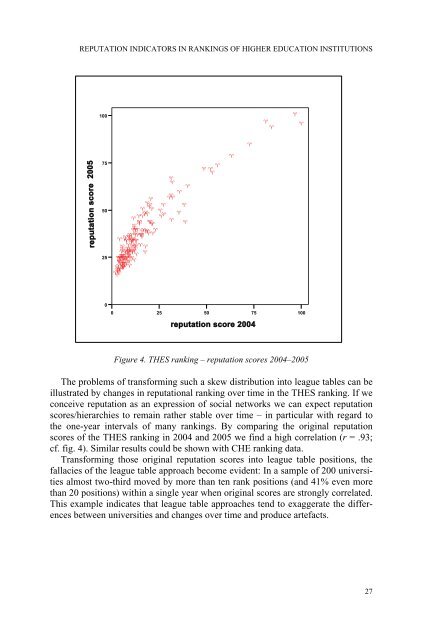University Rankings, Diversity, and the New ... - Sense Publishers
University Rankings, Diversity, and the New ... - Sense Publishers
University Rankings, Diversity, and the New ... - Sense Publishers
Create successful ePaper yourself
Turn your PDF publications into a flip-book with our unique Google optimized e-Paper software.
REPUTATION INDICATORS IN RANKINGS OF HIGHER EDUCATION INSTITUTIONS<br />
100<br />
<br />
<br />
<br />
<br />
<br />
75<br />
<br />
<br />
<br />
<br />
reputation score 2005<br />
50<br />
25<br />
<br />
<br />
<br />
<br />
<br />
<br />
<br />
<br />
<br />
<br />
<br />
<br />
<br />
<br />
<br />
<br />
<br />
<br />
<br />
<br />
<br />
<br />
<br />
<br />
<br />
<br />
<br />
<br />
<br />
<br />
<br />
<br />
<br />
<br />
<br />
<br />
<br />
<br />
<br />
<br />
<br />
<br />
<br />
<br />
<br />
<br />
<br />
<br />
<br />
0<br />
0 25 50 75 100<br />
reputation score 2004<br />
Figure 4. THES ranking – reputation scores 2004–2005<br />
The problems of transforming such a skew distribution into league tables can be<br />
illustrated by changes in reputational ranking over time in <strong>the</strong> THES ranking. If we<br />
conceive reputation as an expression of social networks we can expect reputation<br />
scores/hierarchies to remain ra<strong>the</strong>r stable over time – in particular with regard to<br />
<strong>the</strong> one-year intervals of many rankings. By comparing <strong>the</strong> original reputation<br />
scores of <strong>the</strong> THES ranking in 2004 <strong>and</strong> 2005 we find a high correlation (r = .93;<br />
cf. fig. 4). Similar results could be shown with CHE ranking data.<br />
Transforming those original reputation scores into league table positions, <strong>the</strong><br />
fallacies of <strong>the</strong> league table approach become evident: In a sample of 200 universities<br />
almost two-third moved by more than ten rank positions (<strong>and</strong> 41% even more<br />
than 20 positions) within a single year when original scores are strongly correlated.<br />
This example indicates that league table approaches tend to exaggerate <strong>the</strong> differences<br />
between universities <strong>and</strong> changes over time <strong>and</strong> produce artefacts.<br />
27














